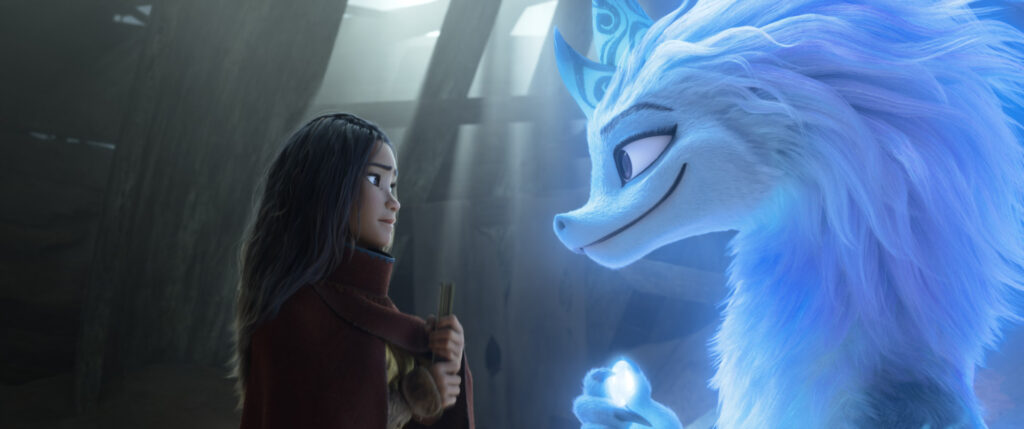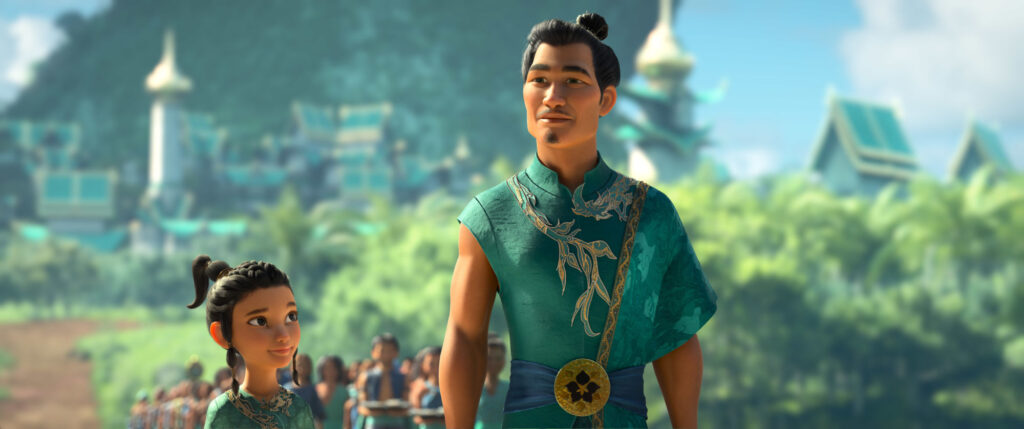Few studios are as synonymous with the term “classic” as Walt Disney Animation Studios. So much so, that “Disney classics” are something of a genre onto themselves. The designation suggests that a film, its characters, and its iconography will be remembered and revered for generations to come. But what makes a “Disney classic”? It’s something we seem to ask ourselves with each new feature released by the studio. Disney’s latest adventure, Raya and the Last Dragon, may have the answer.

Directed by Don Hall and Carlos López Estrada, Raya takes place in Kumandra, a fantasy world inspired by Southeast Asian cultures and geography. When an evil plague known as the Druun drives Kumandra to desolation, a lone warrior named Raya (Kelly Marie Tran) embarks on a quest to find the fabled “last dragon” (Awkwafina) and stop the evil before it’s too late. The setup is as by-the-numbers as it gets, but what separates—and elevates—Raya from the crowd are the compelling interpersonal relations between its characters and their world.
Kumandra is a character in and of itself. The world is comprised of five lands (Heart, Fang, Talon, Tail, and Spine), each with distinct personalities and atmosphere. The seedy nightlife of Talon, differs vastly from the peaceful paradise of Heart. As Raya traverses these eclectic regions, you never know what to expect or who you’ll meet. It makes for a consistently engaging journey. It helps that visually, Kumandra is amongst the most gorgeously-realized worlds seen in animation. It achieves believability, without relying on photorealism. Kumandra’s colors vibrantly pop off the screen in a way that only animated settings can, but the environmental detail convinces you that this world can, and does, exist.

The geographical layout of Kumandra also lends itself to the film’s action sequences, which are abundant and appropriately rousing. The fast-paced combat is elegantly choreographed, with weight given to every punch and swing of the blade. It’s fun, thrilling, and unlike anything we’ve seen from Disney before. Of course, these action sequences need emotional relevance, otherwise they wouldn’t resonate. Fortunately, Raya and the Last Dragon is driven entirely by emotion. The characters each have personal, concrete motivations that drives their place in the story. When Raya makes a decision, you fully understand why. As much as time is devoted to the thrills and spectacle, Raya and the Last Dragon is most concerned with establishing who its characters are and why their journey matters. The Druun plague is not an obscured force that only devastates through implication. We see its tragedy firsthand. It’s a classic (and much appreciated) case of “show-don’t-tell”. And in taking this approach, Raya ensured that I as an audience member, cared. Cared about the characters, cared about their struggles, cared about the film. That, by my estimation, is the most important thing that a movie can do.

That said, the characters are the heart and soul of Raya and the Last Dragon. Raya has an edge that makes her an intriguing protagonist to follow. She’s as cynical and cutthroat, as she is sympathetic and headstrong. Yet for all the jadedness that the role demands, Kelly Marie Tran’s performance ensures that Raya’s humanity is never lost. Awkwafina as Sisu is the spiritual successor to Cliff Edwards as Jiminy Cricket and Robin Williams as the Genie. She boasts the film’s funniest lines, but also the most poignant. There’s a wit and intelligence to the character, while also leaving room for personal growth of her own. The supporting cast, such as the con-baby Noi (Thalia Tran) and formidable giant Tong (Benedict Wong), are all largely endearing. One notable standout is Raya’s villainous rival, Namaari (Gemma Chan), whose connection to the story surpasses even Disney’s best antagonists of the past. All the same, Chan’s venomous delivery sucked me in whenever the character was onscreen.
There’s something to be said about the film’s music. This is not a musical, there are no singing-and-dancing dragons or anything of the like (though I would have personally loved that). Regardless, there’s a powerful score by James Newton Howard that elevates every scene. At times understated, at times bombastic, but all-around effective. This is Howard’s first Disney animated feature since Treasure Planet back in 2002 and I must say, it’s great to have him back.

At the center of Raya and the Last Dragon is the theme of trust; the trust we have in ourselves and the world around us. And, how a lack of trust will ultimately destroy us. This overarching message is perhaps Raya’s weakest link, for no other reason than its predictability. You can guess the outcome from the first frame of the movie. While the film’s emotional beats still manage to soar in spite of this, such a familiar lesson can suck out some of the mystique. None of this is to take away from the relevance and importance of Raya’s message. And at times, the film takes a more nuanced approach that adds layers to the subject matter. At the end of the day, the execution is where it counts, and the execution is where Raya ultimately succeeds.
Raya and the Last Dragon has all the hallmarks of a Disney “classic”. It’s entertaining, stunningly beautiful, and most importantly sincere. Nothing about this movie feels cold or calculated, like a checkbox was signed off during its making. It has a story to tell, an engaging world to present, and wonderful characters for us to follow. It’s an example of Walt Disney Animation Studios at their best.
Raya and the Last Dragon is now playing in theaters, and is available to order on Disney+ with Premier Access.







